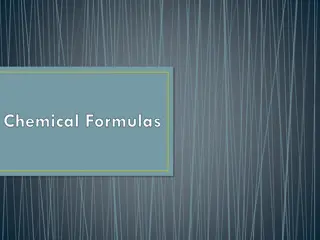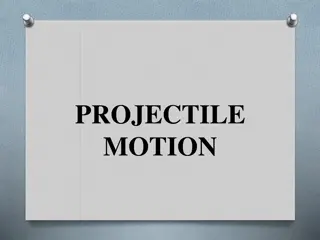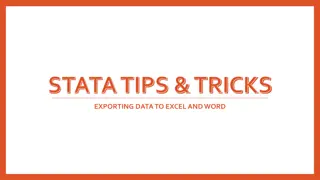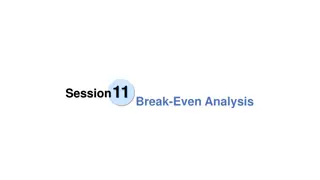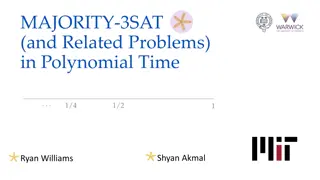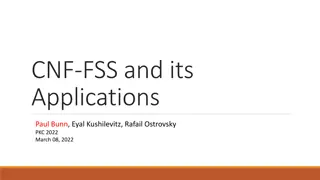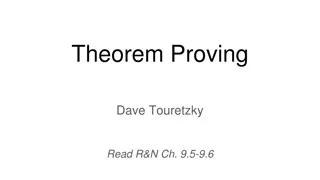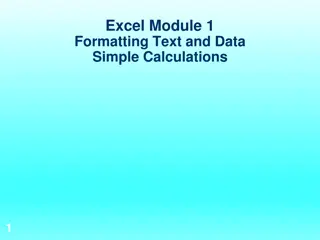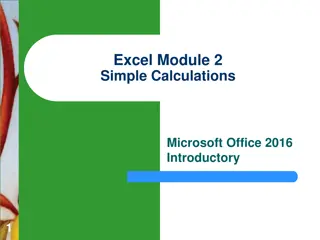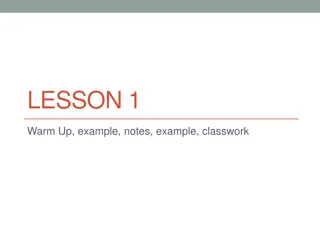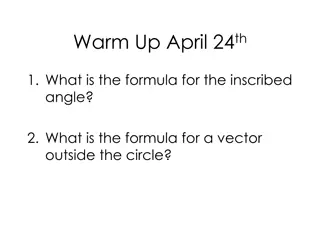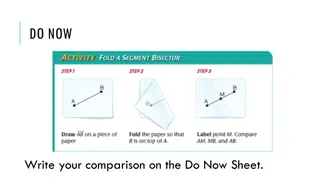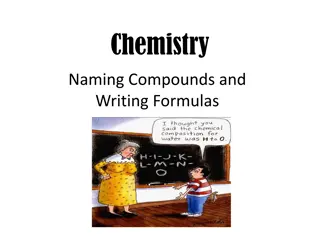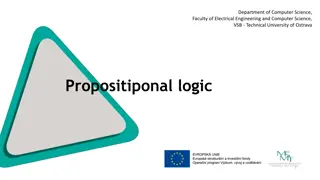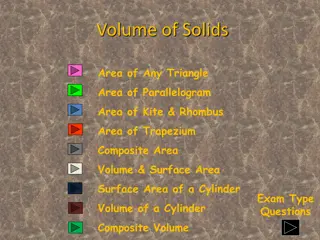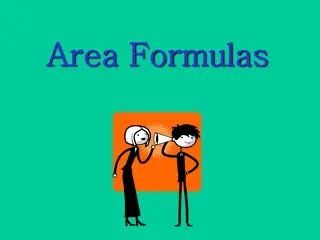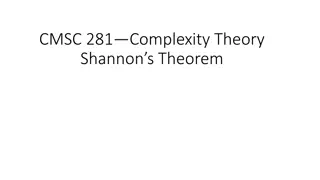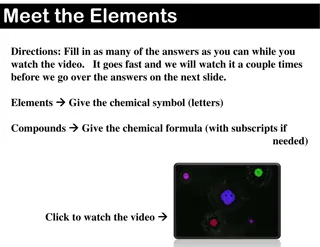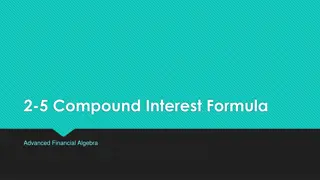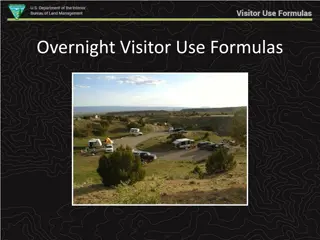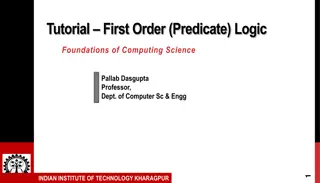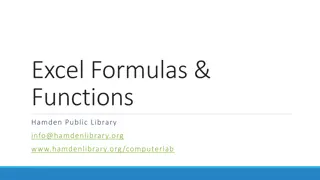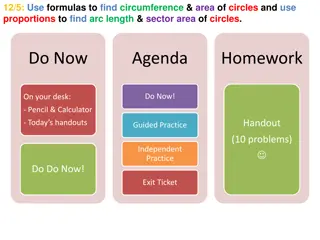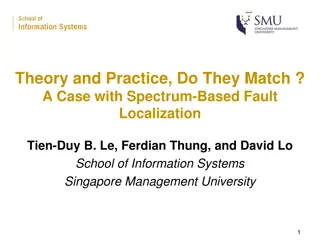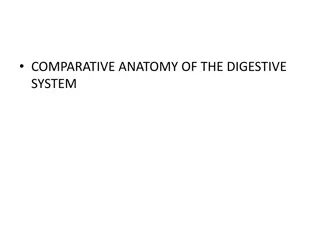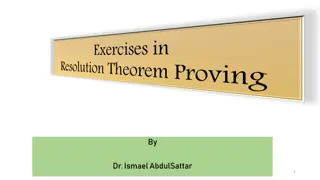Chemical Formulas, Reactions, and Equations
Explore the world of chemical formulas, reactions, and equations, understanding how they identify substances and represent the composition of compounds. Learn about the significance of balanced chemical equations and the role of subscripts in indicating the number of atoms present in a molecule. Dis
1 views • 44 slides
Projectile Motion: Characteristics, Examples, and Formulas
Projectile motion involves the motion of objects under the influence of gravity, with both vertical and horizontal components. This type of motion is seen in activities such as throwing a ball, kicking a football, or dropping objects. The motion is described by specific formulas, including calculati
2 views • 19 slides
Exporting STATA Results to Excel Using PutExcel Feature
Learn how to utilize the PutExcel feature in STATA to effortlessly export your results to an Excel file. With PutExcel, you can export matrices, stored results, images, estimation tables, and even add formulas for calculations. This tool streamlines the process of transferring statistical data to Ex
6 views • 32 slides
Time Reversal Test in Price Index Formulas
In the realm of price index formulas, the Time Reversal Test (TRT) plays a crucial role in determining the applicability of various index calculation methods. Professor Fisher introduces tests like TRT, FRT, and Circular Test to gauge formula efficiency. TRT demands that the calculated index remains
2 views • 17 slides
Break-Even Analysis and CVP Formulas
Dive into the world of break-even analysis and cost-volume-profit formulas to analyze business profitability. Learn about breakeven revenue, contribution/sales ratio, weighted average C/S ratio, and more through practical examples. Explore the significance of break-even charts and profit-volume char
1 views • 11 slides
Complexity in Polynomial Time: MAJORITY-3SAT and Related Problems
Dive into the world of MAJORITY-3SAT and its related problems, exploring the complexity of CNF formulas and the satisfiability of assignments. Discover the intricacies of solving canonical NP-complete problems and the significance of variables in determining computational complexity.
3 views • 35 slides
CNF-FSS and Its Applications: PKC 2022 March 08
Explore the Background, Applications, and Summary of CNF-FSS, focusing on Function Secret Sharing, Distributed Point Function, CNF Key-Sharing, and more. Learn about the efficiency of multiparty sharing and 1-out-of-3 CNF-FSS constructions for certain classes of functions. Discover how CNF Key-Shari
1 views • 33 slides
Resolution in Theorem Proving
Exploring the process of resolution in theorem proving, starting from propositional resolution to the complexities of First-Order Logic. The conversion of FOL sentences to CNF, elimination of implications, variable standardization, Skolemization, and dropping universal quantifiers are all dissected
0 views • 34 slides
Area of a Circle: Understanding Formulas and Calculations
Learn all about calculating the area of a circle, including the formulas for radius and diameter, the significance of Pi, and examples to help you grasp the concept clearly. From understanding the circumference to using the formula to find the area, this information-packed resource will guide you th
0 views • 11 slides
Mastering Excel Module 1: Text Formatting and Simple Data Calculations
Explore the fundamentals of Excel Module 1, focusing on formatting text, handling data, and performing basic calculations. Learn essential functions like SUM, COUNT, COUNTA, and AVERAGE. Discover key concepts such as using formulas, editing cell data, and working with functions. Enhance your skills
2 views • 11 slides
Mastering Excel Formulas and Functions for Efficient Data Calculation
Delve into the essentials of Excel formulas and functions to streamline your data calculation tasks effectively. Learn about the components of formulas, order of operations, popular functions like SUM, COUNT, and AVERAGE, and how to create, copy, and apply themes to your calculations. Discover the p
0 views • 9 slides
Mathematical Analysis of Extrusion Parameters and Formulas
Mathematical analysis of extrusion involves understanding key parameters such as extrusion ratio, pressure, and extrusion strain in direct and indirect extrusion processes. Empirical formulas, like Johnson's equation, are used to estimate strain and pressure in extrusion operations. Friction between
0 views • 7 slides
Sequences and Patterns in Mathematics
Dive into the world of sequences and patterns with examples and exercises involving identifying patterns, writing formulas, and graphing terms on coordinate planes. Explore different scenarios and learn to express nth terms in sequences. Understand the importance of indexing terms and using proper f
0 views • 48 slides
Circles: Formulas for Inscribed Angles and Circumference
Explore the formulas for inscribed angles, vectors outside the circle, and the circumference of a circle. Learn how to calculate the circumference using radius, diameter, or directly measure the arc length. Discover the relationship between arc length and the angle measure in a circle.
1 views • 25 slides
Geometry Formulas and Examples for Midpoint and Distance Calculations
Explore the midpoint and distance formulas in geometry with detailed explanations and examples. Learn how to find midpoints, endpoints, and distances between points on a coordinate plane. Enhance your understanding of segment bisectors and midpoint calculations through practical illustrations.
0 views • 12 slides
Chemical Bonding and Compound Formulas: Understanding Ionic vs. Covalent Bonds
Explore the differences between ionic and covalent bonds, learn about ionic compounds held by electromagnetic attractions, understand molecular compounds with shared electrons, and grasp the naming conventions for ions. Discover how molecular formulas and formula units represent atoms in compounds.
1 views • 56 slides
Chemistry: Naming Compounds and Writing Formulas
Understand compounds, chemical formulas, and how to write ionic formulas using the Swap 'n Drop Method. Learn about types of compounds - ionic, covalent, and acids, and practice writing formulas for various elements. Follow rules, naming flow charts, and partner activities to enhance your understand
1 views • 13 slides
Normal Forms in Propositional Logic
Explore the concept of normal forms in propositional logic, where each formula has a unique truth-value function. Learn about equivalence of formulas, determining normal forms, and canonic forms like Disjunctive Normal Form (DNF) and Conjunctive Normal Form (CNF). Discover how to find canonic forms
2 views • 22 slides
Satisfiability Modulo Abstraction for Separation Logic with Linked Lists
This study explores the application of satisfiability modulo abstraction in separation logic with linked lists. It presents a technique using abstract interpretation concepts to handle separation logic formulas beyond previous methods, specifically focusing on over-approximating heaps that satisfy t
0 views • 41 slides
Geometric Formulas for Area of Various Shapes
Explore formulas for finding the area of different geometric shapes such as triangles, parallelograms, rhombuses, kites, and more. Learn how to calculate areas efficiently and apply them to solve problems with units. Utilize diagrams and examples to grasp the concepts effectively.
0 views • 39 slides
Area Formulas and Shapes
Explore area formulas for rectangles and squares, learn how to calculate areas, discover shapes formed by cutting rectangles in half, and understand the transition of formulas when rectangles are transformed into triangles.
0 views • 113 slides
Circuit Size Bounds in Complexity Theory
The article delves into Shannon's Theorem in Complexity Theory, discussing the upper bounds of circuit sizes for Boolean functions of n variables. It explores the 1-1 correspondence with 0-1 strings of length 2n and how Boolean functions can be expressed as CNF or DNF formulas. The computation of th
2 views • 19 slides
Chemical Bonding: Valency, Formulas, and Reactions
Explore the world of chemical bonding with this unit covering valencies, chemical formulas, ionic vs. covalent bonds, and exothermic vs. endothermic reactions. Learn to predict element combinations, create molecular formulas, and differentiate between various bond types. Jigsaw diagrams demonstrate
1 views • 46 slides
Fun Chemistry Activity: Meet the Elements
Engage in a fun and interactive chemistry activity where you watch a video to fill in chemical symbols and formulas of elements and compounds. This educational exercise involves identifying elements in everyday objects like rust, sugar, and propane. Learn about chemical formulas for common substance
0 views • 4 slides
Compound Interest Formulas in Advanced Financial Algebra
Compound interest involves earning interest not only on the principal amount but also on the accumulated interest. This concept allows money to grow faster over time. By using formulas for periodic compounding, you can calculate the ending balance of investments with different compounding frequencie
1 views • 8 slides
Overnight Visitor Use Formulas Summary and Examples
Explore the overnight visitor use formulas for different campgrounds - North Fruita Desert Campground and Loon Lake Campground. Understand the average visitor stay duration, activities like camping, picnicking, swimming, fishing, hiking, and water play, along with their respective percentages and to
0 views • 5 slides
Overview of Proposed Changes in Producer Price Index Formulas
The U.S. Bureau of Labor Statistics is considering transitioning from a modified Laspeyres formula to a geometric Young formula for elementary indexes in the Producer Price Index (PPI). This proposed change aims to enhance the accuracy and economic relevance of price measurements by utilizing a geom
0 views • 25 slides
Chemical Formulas and Subscripts in Chemistry
Chemical formulas and subscripts are fundamental concepts in chemistry for expressing the composition of substances at the molecular level. This article explores the significance of chemical formulas in representing elements and compounds like water (H2O), carbon dioxide (CO2), sodium chloride (NaCl
0 views • 37 slides
Predicate Logic Problems and Solutions
Explore various scenarios and challenges in predicate logic, from converting statements to normal form to reasoning using predicate logic. Dive into encoding sentences in first-order logic, understanding FOL formulas, and formalizing sentences with FOL formulas.
2 views • 7 slides
Retirement Plan Comparison: University of St. Michael's College vs. UPP
A comparison of retirement plan provisions and benefits between the University of St. Michael's College and UPP reveals that UPP offers top value for contributions among Canadian DB plans. The plan provision details include contribution percentages, benefit formulas, employee and employer contributi
0 views • 12 slides
The Power of Excel Formulas and Functions
Unleash the potential of Excel with a comprehensive guide on formulas, functions, and operators. Learn the syntax, order of operations, cell references, and more to streamline your calculations and data manipulation. Dive into the world of nested functions, logical tests, and the essential Ribbon an
0 views • 24 slides
Circles: Formulas for Circumference, Area, and Proportions for Arc Length and Sector Area
Learn how to calculate the circumference and area of circles using formulas, and use proportions to find arc length and sector area. Master the concepts through examples and practical applications in geometry.
0 views • 18 slides
Geometric Solids Volume Formulas Explained
Understanding the volume of geometric solids is crucial for various practical applications. Learn about different shapes like rectangular prisms, cylinders, cones, and spheres, along with their respective volume formulas. Dive into the concepts of diameter, radius, and height to master calculations
0 views • 13 slides
Geometry Formulas and Classifications
This content covers various geometry topics such as classifying polygons, determining side lengths, identifying shapes using slope formulas, and more. Detailed explanations, formulas, and calculations are provided along with visual aids for better understanding.
0 views • 8 slides
Acids and Bases in Chemistry
Acids and bases play essential roles in chemistry, where they release hydrogen ions or hydroxide ions when mixed with water. Acids, like vinegar and lemon juice, are corrosive and can cause chemical burns. On the other hand, bases, such as bleach and dish soap, contain the hydroxide group in their f
0 views • 19 slides
Theory and Practice: A Case with Spectrum-Based Fault Localization
This study explores the alignment between theory and practice in the context of Spectrum-Based Fault Localization (SBFL). It delves into the analysis of execution traces, assigning suspiciousness scores to program elements, comparing SBFL formulas like Tarantula and Ochiai, and introducing new formu
0 views • 15 slides
Overview of Comparative Anatomy of Digestive Systems and Dental Formulas in Various Animal Species
This content provides a detailed comparison of the digestive systems and dental formulas in different animal species including horses, ruminants, pigs, dogs, cats, and fowls. It delves into the unique characteristics of their tongues, papillae, soft and hard palates, as well as specific features lik
0 views • 22 slides
Logical Resolution Proofs and Exercise Solutions
This content provides exercises on logical resolution proofs and solutions, including proving that "West is a criminal" and resolving statements related to mortality, relationships, and more. It also covers converting statements to Conjunctive Normal Form (CNF).
0 views • 9 slides
Algebraic Complexity and Equational Proofs in Arithmetic Formulas
Explore the intricacies of polynomial identity testing (PIT), equational proofs, and arithmetic formulas in the context of algebraic complexity. Learn about the minimal number of operations needed to compute the zero polynomial and derive new identities using derivation rules and axioms in polynomia
0 views • 39 slides
A Parent's Guide to Transitioning Between Baby Formulas Making the Switch Safely
Switching baby formulas requires patience and careful observation. Whether transitioning to Holle, HiPP, or another organic formula, a gradual approach ensures a smoother process. Every baby is unique, so stay flexible and attentive to their needs.\n
0 views • 7 slides
